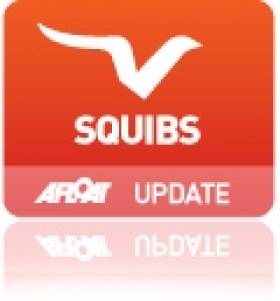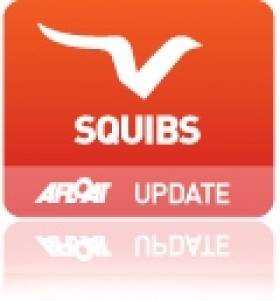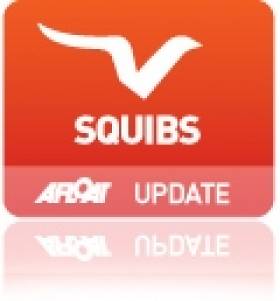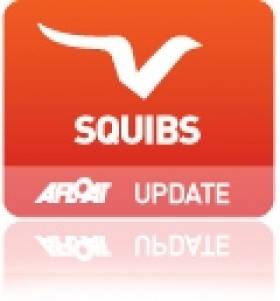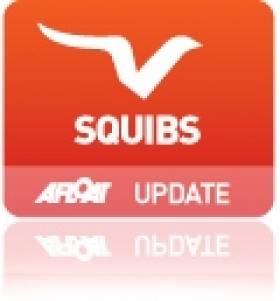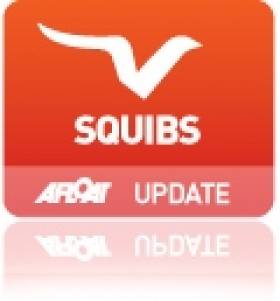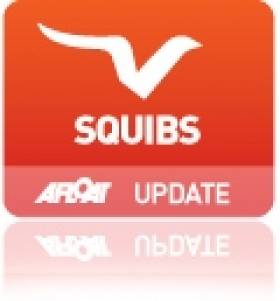Displaying items by tag: squib
#squib – An overall win of Aberdeen Asset Management Cowes Week for the second year in a row has further endorsed the Squib's reputation as one of the most successful, versatile and affordable small racing keelboats on the market writes Sue Pelling.
Corinthian sailors Malcolm Hutchings and crewman Andy Ramsey sailing Lady Penelope not only won their class at Cowes Week from a highly competitive 31-boat fleet, but also won White Group overall, and were deemed overall winners of the week from the 800 plus fleet beating Adam Gosling's Corby 36 Yes! – winner of Black Group – for the second year running.
While there is no doubt that Hutchings and Ramsey's impressive sailing skill and teamwork led to their ultimate win, their passion for the 47-year-old class is what really spurs them on. As fine class ambassadors they have proved once again that winning the biggest regatta of its type in the world is not all about spending big bucks but more about good, consistent competition and maintaining a healthy class status within a fleet.
With over 500 members including a strong youth contingent, 35 fleets around the British Isles, plus boats in France, Denmark, Germany and the Caribbean, the Squib class is booming. The recent appointment of Rondar Raceboats as the new builder is good news too because it means more used boats are likely to be on the market once production of new boats is underway.
Hutchings and Ramsey, from Burnham-on-Crouch on the east coast, say that 13-year-old Lady Penelope is a fine example of the sort of results an ageing Squib can achieve: "Age is not an issue in the Squib class it's all about keeping the fleet alive. Because she is a one-design, nothing really changes, so it is possible to pick up relatively old boat for a good price and, and as long as it is maintained well, there is no reason not to do well. The key is to keep everything in tip top condition as this will ensure the Squib class is winning in years to come."
With 31 boats on the water, the Squib class was the second largest one-design fleet after the X-One Designs at Aberdeen Asset Management Cowes Week this year. Endorsing the ethos of the class, which encourages 'sailing for all', Cowes Week attracted eight under 25-year-olds including the youngest at just 12. Twenty-two of the boats had family members on board, and a third of the fleet girls including five at the helm.
Steve Warren-Smith – chairman of the class association – crewing for Sarah Everitt on Aquabat, were the only team to beat Hutchings and Ramsey in a race during Cowes Week. Warren-Smith concluded: "Winning Cowes Week in a Squib is a bit like winning the Champions League with the local village team, or winning a Grand Prix in a go-cart. It's the ability that counts, not the wallet!"
Squib Nationals Won By Vaughan Cousins on Belfast Lough
#squib – Cousins Ross and Andrew Vaughan, in 'Joint Venture', have secured the Rodgers & Browne Squib Irish Championship in mixed weather conditions at Royal North of Ireland Yacht Club at the weekend.
Supported by North Down Borough Council, the event attracted 24 boats from all over the island of Ireland. A strong local Royal North contingent was boosted by visitors from Howth, Dun Laoghaire and strong representation from Killyleagh Yacht Club and the Quoile.
Day one brought perfect sailing conditions – bright sunshine and 10-12 knots of breeze - which made for exciting, close racing and a bar full of smiling sailors when they all returned ashore. The first raced ended with a near photo finish. 'Joint Venture' (RNIYC) won by inches from 'Inshallah' (David Eccles/Phil Hutchinson, RNIYC) and 'Quickstep III' (Gordon Patterson/Ross Nolan, RNIYC). In Race 2, 'Inshallagh' secured first place and the third race was won by 'Perfection' crewed by Jill Fleming and Conor O'Leary from the RSGYC. After three races 'Aficionado' crewed by John Driscoll and David Cagney (RNIYC) were topping the leader board by one point from 'Joint Venture', followed by 'Quickstep III' in third place.
However, the tail end of hurricane Bertha made its presence felt on Sunday and the sun was replaced with continuous rain and a stiff breeze. Smiling faces were hard to find as sailors left the warmth of the club house to head out to the moorings for the scheduled three races. The north easterly wind direction meant that the race area was close to the moorings and racing got underway after a short postponement as a result of a slightly shifting breeze.
The conditions suited the Vaughans and they got line honours in all three of the day's races with 'Aficionado' clocking in three second places. 'The Worm' (Sam Lyness/Eric Hayes, RNIYC), 'Quickstep III' and 'Kerfuffle' (Jonathan Craig/Hazel Ruane, Howth YC) secured third place in races four, five and six respectively.
This left the Vaughans four points ahead of 'Aficionado' overnight and 'Quickstep III' in third place. However, the Vaughans' 10 point discard coupled with John Driscoll and David Cagney's consistent scoring meant that the race for the Championship was far from over. Race seven was certainly shaping up to be an interesting one...
Monday morning dawned bright but very breezy with a number of boats deciding not to race. 'Inshallah' led the race at the first windward mark with 'Joint Venture' and 'Aficionado' in hot pursuit. However by the next lap, 'Joint Venture' had managed to pull out into the lead. However, in the end it was 'Aficionado' that crossed the line first with 'Joint Venture' second and 'Quickstep III' in third. Second place was enough to secure the Championship for the Vaughan cousins in 'Joint Venture'.
The Squib Class will now focus its attention on the Inland Championship in Lough Derg in October.
#squib – Reigning Irish Squib keelboat champions James and Bruce Matthews from Kinsale Yacht Club will battle with past winners and recently crowned Eastern Champions, John Driscoll/David Cagney, and Northern Champions, David Eccles/Michael Wright, all of whom are in contention for the main Irish Championship prize at Royal North of Ireland Yacht Club.
As Afloat previously reported, the Rodgers & Browne Squib Irish Championship, supported by North Down Borough Council, will be held on Belfast Lough over the 9th - 11th August and will attract Squibs from throughout Ireland to compete for the trophy.
The Squib Class is one of the largest one design keelboat classes in Ireland. It is sailed by two people and is well known for its distinctive brown sails. Over the
last decade fleets have flourished at Killyleagh Yacht Club, Quoile Yacht Club, Royal St George Yacht Club and Kinsale Yacht Club, in addition to the traditional strongholds of Cultra and Howth Yacht Club.
#squib – They came from far and near to compete in the Squib South Coast Championship at glorious Glandore. Beautiful weather but light or no wind provided Principal Race Officer Nigel Kearney with challenging conditions to run the planned 3 races on the Saturday 19th July. Nigel achieved two shortened races but was forced to abandon the third race on the first beat, due to a significant fading wind shift. Patience and prayer would not suffice and all sailors were directed to the shore.
Race 1 saw Anemos, helmed by Pete Evans in first, Quickstep III helmed by Gordon Patterson second and Perfection helmed by Jill Fleming in third.
Race 2 provided a win for Lola helmed by Frank Whelan, second for Quickstep III and a third place for Anemos. Allegro improved to fourth, but posed no overall threat.
Sunday the 20th began with a light, but dying land breeze; racers wallowed around for approximately two hours for the wind gods to return to normal service. Race 4 commenced with a 10 to 15 knots of wind and sunshine – champagne sailing. From way back in the rankings, Allegro now found the groove and produced a sparkling first place finish, with Lola, and Quickstep III in close order. Effective points now were 5, 3 & 4 respectively.
In what would transpire to be the last race of the event Allegro pulled a dramatic first to Quickstep III's second, with Why Not helmed by Derek Jago, crashing the party with a third place, relegating Lola to fourth in this race.
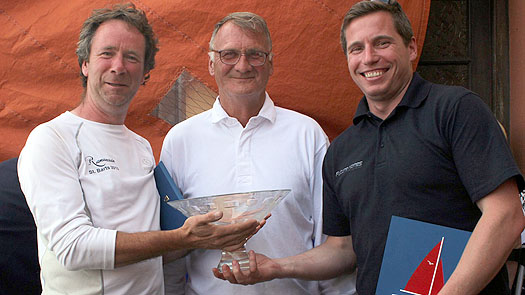
(left to right) - Colm Dunne, John Dowling Commodore, GHYC and Rob Gill. Photo: Mary Casey
Final effective points in the Gold Fleet were Allegro and Quickstep III, tied on 6 points each and Lola with 7 points, which was resolved by the scorer using appendix A8.1. The final result was first Allegro from KYC, second Quickstep III from RNYC and third Lola RSGYC.
In the Silver Fleet, John Stanley on Bateleur, KYC, took third, local hotshot Pat O'Riordan , GHYC on Blue Bottle placed second, and Colm Daly on Lazarus placed first.
#squib – In August, the Squib Class will be returning to the southern shores of Belfast Lough and the Royal North of Ireland Yacht Club.
The Rodgers & Browne Squib Irish Championship, supported by North Down Borough Council, will be held over the 9th- 11th August and will attract Squibs from throughout Ireland to compete for the national trophy.
The Squib Class is one of the largest one design keelboat classes in Ireland. It is sailed by two people and is well known for its distinctive brown sails. Over the last decade fleets have flourished at Killyleagh Yacht Club, Quoile Yacht Club, Royal St George Yacht Club (Dublin) and Kinsale Yacht Club, in addition to the traditional strongholds of Cultra and Howth Yacht Club.
The reigning champion pairing of James and Bruce Matthews from Kinsale Yacht Club will battle with past winners and recently crowned Eastern Champions, John Driscoll/David Cagney, and Northern Champions, David Eccles/Michael Wright, all of whom are in contention for the main prize.
Thomas Anderson, Commodore of the Royal North commented "I am delighted to welcome the Squib Irish Championship back to Cultra. This has only been possible with the ongoing support of Rodgers & Browne and North Down Borough Council. The Squib Class has been the backbone of our Club for several decades and it is fantastic that the fleet will be showcased through this event. In addition to the excellent sailing waters of Belfast
Lough, the Club's well known hospitality will ensure that this event will be well worth attending".
Connor Browne, Partner at Rodgers & Browne, said "We are looking forward to collaborating again with the Royal North of Ireland Yacht Club and the Squib Class to bring the Irish Championship to Cultra. North Down is a stunning location for many sporting activities, which is reflected in the demand for housing within the greater Holywood, Helen's Bay and North Down areas."
#squib – 25 Squibs keelboats will compete for the first time for Southern Championship honours on July 19 at Glandore in West Cork. Ten visitors are expected to join a local fleet of 15 according to Glandore Harbour Yacht Club Commodore John Dowling.
#squib – The key to a successful cruise is good organisation. Plan ahead, select your destination, ensure that the tide is going in a favourable direction, ensure that the facilities at your place of arrival are adequate for your group of cruisers, and that the weather is fine writes Vincent Delany.
A Squib class event was conceived on 12th June after club racing, to cruise on the following Saturday to Howth, on the opposite side of Dublin Bay, on the expectation of a fish and chip lunch at Beshoff's famous fish shop, followed by a leisurely pint at Howth Yacht Club.
All did not go to plan.
There was a high pressure system sitting over the east coast of Ireland on Saturday morning with about 1 knot of wind from the north. It took the seven squibs, (Jill, Conor and Dermot in Perfection, Vincent and Joe in Femme Fatale, Gerry and Elena in Buzz Lite, Sheila and Gilly in Little Demon, Rupert and Emily in Sidewinder, Fergal and Wendy in Aija and Derek and Jean in Why Not) at least an hour to sail from the Royal St George Yacht Club to the Dun Laoghaire Harbour mouth. At that rate of progress they were guaranteed not to have a favourable tide all the way to Howth Harbour. What should they do? It was agreed to raft up and put the thinking hats on! Then a small breeze from the north east appeared. Somebody suggested "Let's go to Clontarf.", the Squibs were pointed in the direction of Poolbeg where two venerable lighthouses mark the entrance to Dublin Port. En route we sailed through hundreds of large racing yachts looking for wind, and when they found it, trying to get it to stay in a constant direction to allow a Bloomsday race to start.
When the first Squibs reached Poolbeg lighthouses, they waited for the others to catch up, before entering the Dublin Port area where Clontarf is on the north shore. The tide was almost full in so there was plenty of depth, except in a few areas which were inevitably unmarked. As the Clontarf fleet were our racing, some moorings were lifted and some anchors dropped in the shallow water. Yes we did know that the moorings dry out at low water. Next question was, how do we get ashore? A launch appeared from nowhere, welcomed us to Clontarf, an asked us where we had come from, and enquired if we wanted to go ashore. Some headed straight to Beshoffs (yes there are two branches of Beshoffs, on in Howth and one in Clontarf.) while others went straight to the Yacht club for refreshment. Peter Reilly asked us if we would like to see the O'Brien Kennedy designed IDRA 14 footer which is currently being built at the back of the clubhouse by the members. She was progressing well with at least half the planking complete. When we came back to the front of the clubhouse the 15 hungry Squibs we consuming huge platters of sandwiches which had been quickly made by Mrs. O'Rourke. It turned out that Clontarf is celebrating the 100 year centenary of another invasion, from the Vikings, so the Squibs were invited to don some Viking helmets.

The Squibs make their way into Dublin Port
After about an hour of chat and gossip, it was time to check our boats in the falling tide. Yes they were all afloat with at least 300mm of water under the keels. An informal race was made out of the return trip, during which some Squibs were nearly run down by freighters entering Dublin Port. The light wind was from the south east, which meant that it was a beat all the way, but with a strong tide under us.
When only a few hundred yards from Dun Laoghaire harbour mouth, the wind disappeared entirely, so it was time to apply some paddle power.
In retrospect, spontaneity can be great fun. We should all spend more time cruising! .
#squib – A strong Royal North of Ireland contingent took the top three places overall at yesterday's 23–boat Squib keelboat eastern championships at the Royal St. George Yacht Club in Dun Laoghaire. Full results are available to download below. Overall winners were 1996 Olympic helmsman John Driscoll sailing with David Cagney on 6 nett points. Second on ten points was Royal North club mates Gordon Patterson and Ross Nolan with third going to Des Clayton and Paul Henry on 20 points. Local Royal St. George crew Pete Evans and Paul Maguire were next home on 22 points.
As well as Royal North of Ireland visitors came from Killyleagh, Royal Irish Yacht Club, and National Yacht Club.
The first three races were held in approx. 15kts. of cold northerly wind with a big confused sea left over from gales of the previous night.
Race 1 was won by Martin Byrne and Joe O'Byrne in 24, Femme Fatale from Pete Evans and Paul Maguire in 832, Anemos and Peter and Marie Dee in 813 Kookaburra. Remarkably each of these Dublin Bay boats is manned by refugees from the Dragon fleet.
Race 2 was won by Olympian John Driscoll and Dave Cagney in 78, Afficianado from Gordon Patterson and Ross Nolan in Quickstep III with Des Clayton and Paul Henry in 794, Inismara. This result with three northern boats is a carbon copy of the final overall placings.
With crews getting tired in the strenuous conditions, Race 3 was won by Quickstep III followed by Afficianado and Anemos
Overnight the leaders were Quickstep III from Femme Fatale and Inismara on equal points. The Royal St. George put on an enjoyable dinner for all the competitors and their friends and partners.
Sunday dawned with very different conditions, sunshine, fickle winds of between 3-6 knots which progressively swung around from the west to the north. Fortunately the waves had declined from the previous day, so the conditions were more kindly to the lighter crews.
Race 4 was won by light air specialist Frank Whelan 46, in Lola from Afficianado and Kookaburra. After 4 races a discard was applied which was beneficial to Afficianado who had missed the first race (for reasons best known to themselves), and Anemos who were able to drop their OCS.
The final race in a falling wind went to Afficianado from best lady Jill Fleming and Conor O'Leary in 44, Perfection and Quickstep III.
In the final line up it was three Royal North of Ireland boats in the top 3 places.
The fleet will compete again next week in The Northern Championships in Killyleagh.
Kinsale Yacht Club Launches One Design Keelboat Regatta
#kinsale – The May bank holiday event saw the inaugural 'Axiom sponsored One Design keelboat Regatta' held in Kinsale YC. Twelve Squibs and five Dragons came out to do battle for the very generous prizes and newly commissioned trophy.
PRO Tony Ireson and his team provided great racing with 6 races held over the two days on a windward leeward course. Saturdays racing was held in 12-18 knots from the south west with the opening races in Dragons been taken by Little fella sailed by Cameron Good/Simon Furney and Henry Kingston.
The Squibs were having a fierce battle with places at the top constantly been swapped with National Champion James Mathews in Mucky Duck, Colm Dunne and Rob Gill in Allegro and Finbarr and Cian O'Regan in Fagin. Kevin Downey knocked in a great day with 4, 4, 5 in his new squib Grey Matter.
Day two saw the wind blowing from due south so Tony Ireson set his line at the mouth of the harbour. Lumpy seas and slightly lighter winds made for difficult sailing but Colm Dunne and Cameron Good found the groove and extended their leads with both finishing as overall winners.
At the prize giving there was great excitement as to which boat would win the newly commissioned trophy and after the criteria was spelt out by sailing secretary John Stallard the first name to go on the trophy is Allegro sailed by Colm Dunne and Rob Gill.
Such was the success of the event club Commodore Finbarr O' Regan was able to announce that Axiom Private Clients are to come on board for 2015 as the main sponsor and the dates were announced as May 2nd &3rd 2015.
#squib – The Royal St George Yacht Club hosts the Irish Squib East Coast Championship 2014 from 24-25 May 2014 writes Squib captain Rupert Bowen.
The Dun Laoghaire class welcomes Squib sailors back to the club, which hosted the Irish Squib Nationals in 2012 with 32 entries and the UK Squib Nationals in 2010 with over 70 entries. 15-20 entries for the Easterns this year, although it could be more (32 boats entered the Squib Inlands in Dromineer last October)
The plan is to run five races over the two days and to award prizes after racing concludes on Sunday 25th May.
The Squib is a 6m keelboat that can appeal to a wide range of sailors and levels of experience, age etc. There are active and growing Squib fleets all around Ireland and Great Britain. In the Dublin Bay fleet we have teenagers and retired men and women and all ages in between! We have sailors who have competed at the highest level internationally as well as people who simply enjoy a race "around the cans" in Dublin Bay. We race around the buoys in Dublin Bay on Tuesday, Thursday evenings and around "Olympic" dinghy courses on Saturday afternoons.


























